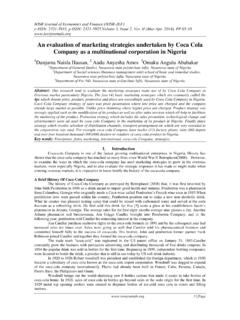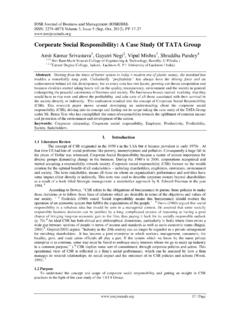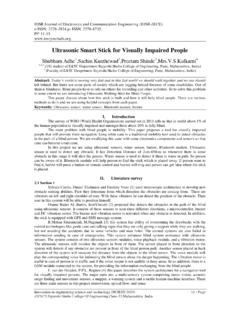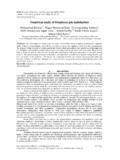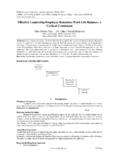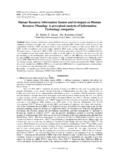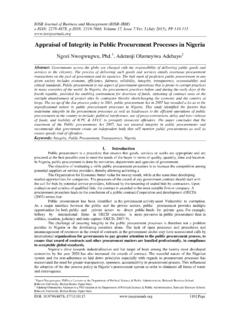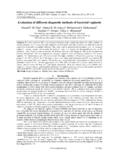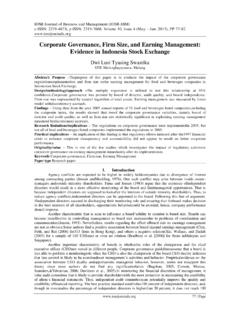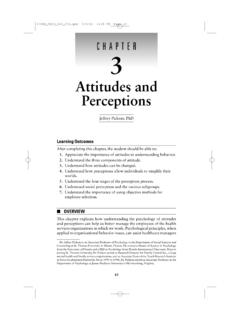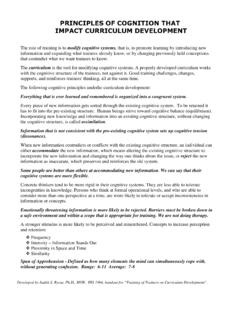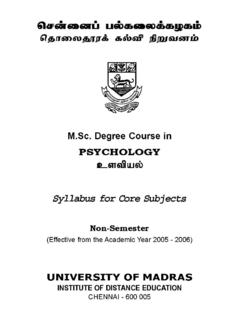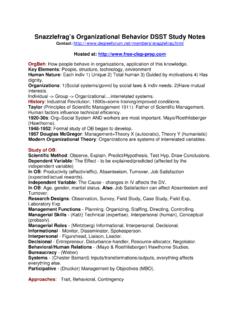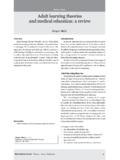Transcription of Cognitive Dissonance and Its Impact On Consumer …
1 IOSR Journal of Business and Management (IOSRJBM) ISSN: 2278-487X Volume 1, Issue 4 (July-Aug. 2012), PP 07-12 7 | Page Cognitive Dissonance and Its Impact On Consumer Buying Behaviour Uzma Hasan, Dr. Reshma Nasreen (Research Scholar, Department of Management Studies, Jamia Hamdard, New Delhi, India) (Associate Professor, Department of Management Studies, Jamia Hamdard, New Delhi, India) Abstract: This article explores the implications of Cognitive Dissonance on varied aspects of Consumer buying behaviour. Some of the factors leading to Dissonance post purchase and prior to it have been comprehensively studied in the article. The paper begins with the identification of the degree of involvement in the purchase of a product which creates Dissonance for a customer. The authors argue that higher the degree of purchase involvement on behalf of the Consumer , the lesser would be his Dissonance level.
2 If he takes the purchase decision on his own, he would be more satiated with his decision as compared to a purchase decision taken in consultation with others. Also it is proposed, that the more time a Consumer devotes to his purchase decision, the more content he would be with his decision and lesser would be the Dissonance attached with the decision. The study also unveils that, a Consumer is likely to face more Dissonance over his decision which involves the purchase of luxury and expensive products whereas less Dissonance was found to be associated with the purchase of FMCG (Fast Moving Consumer Goods). In other words, purchase of luxury products would make customers more dissonant as compared to a purchase of FMCG products. Keywords: Cognitive Dissonance , Consumer behaviour, marketing, Consumer Dissonance , post purchase Dissonance I. INTRODUCTION For ages, Dissonance in Consumer behaviour has captured the imagination of the marketers the world over.
3 Since Consumer behaviour and its extensive study has been a backbone of the marketing strategy of every firm, a detailed and comprehensive study of all its aspects become imperative for the success of an organisation. And, hence, the concept of Cognitive Dissonance and its effect on the Consumer behaviour has been a part of various significant research studies as well. One author even termed it one of social psychology s greatest theories (Aronson 1969). Sweeney, Hausknecht and Soutar (2000, p. 383) noted, Dissonance includes both Cognitive aspects, as the title Cognitive Dissonance implies, as well as an emotional dimension, as many definitions, including Festinger s original definition, imply . A social psychologist describes Cognitive Dissonance as a psychological phenomenon that occurs when there exists a discrepancy between what a person believes in and the outcome which questions a person s belief (Festinger, 1957).
4 Festinger described Cognitive Dissonance as a state which comes into existence when a person gets confused between two cognitions (thoughts), which cannot exist together and hence create tension for him. As the person believes both the thoughts to be true, it invokes mental tension in his mind. The resulting Dissonance motivates the individual to bring harmony to inconsistent elements and thereby reduce psychological tension. Dissonance is known to arise mainly in three ways First, any logical inconsistency can create Dissonance . Second, Dissonance can be created when a person experiences an inconsistency either between his attitude and his behaviour or between two of his behaviours. Third, Dissonance can occur when a strongly held expectation is disconfirmed, notes Loudon & Della Bitta (2002). However, it must be noticed that in all the above mentioned three conditions, Dissonance is not automatic.
5 Rather it is imperative for a Consumer to perceive the inconsistency; otherwise, no Dissonance will occur. Further, Dissonance occurs once a decision has been made as prior to making a decision an individual had an option of adjusting to any attitude or behaviour which he deemed right as per his choice but once a decision is being made, a commitment has been established between the buyer and the Consumer , where he cannot further adjust himself and is liable to stick to his decision. This commitment and restriction might invoke Dissonance in the Consumer . II. PREVIOUS RESEARCH Once the purchase has been made, a human mind starts assessing the pros and cons of the purchase transaction made. This activity leads to emanation of myriad of conflicting thoughts in the mind of the buyer. The positive aspects of a choice forgone and the negative aspects of the decision made create ascending strain in Cognitive Dissonance And Its Impact On Consumer Buying Behaviour 8 | Page the human mind and make the buyer rethink about the decision made, notes Kassarjian and Cohen (1965).
6 Dissonance though is a psychological concept but has a great bearing on the way consumers plan their purchase and effect of the purchase made on their future alliance with the organisation. In an era of marketing, where a Consumer is spoilt with a plethora of choices as regarding the product to buy, it is difficult to avoid a situation of confusion which leads to Dissonance among the consumers. However, consumers make their efforts in different ways to reduce the conflicting views which arise in their mind. When a purchase transaction gets completed, most of the consumers feel that their decision has got hugely effected by the sales interventions being made by the seller and hence their Cognitive consistency has been compromised to the various marketing interventions made by the seller (Bell, 1967; and Cummings and Venkatesan, 1976). A Consumer after making a desired decision may feel that by choosing a certain brand, he has forgone the positive traits of an alternative brand which he could have possessed if he had chosen the alternative brand.
7 The guilt might get accentuated if bought brand doesn t perform as per the desired expectations of the consumers. In such a scenario, the Consumer might ignore the positive traits associated with a product and consider them redundant. Though Dissonance can be felt by the Consumer at any stage during the buyer s decision making process, it is during the post purchase stage that Dissonance could cause even emotional discomfort in the Consumer s mind. However, a Consumer can try varied ways to reduce the Dissonance - (1) through rationalization (2) he may seek additional information which is in consistent with the behaviour that he has shown and (3) by forgetting some of the dissonant elements and by changing his attitude and shifting it in favour of the decision made by highly emphasizing on the positive aspects of the decision being made. Cognitive Dissonance can categorically be found not only in the post purchase stage but is easily visible in the pre decision stage as well, according to Koller and Salzberger (2007).
8 Dissonance has the power to make the complete buying experience as sour and unfriendly. In order to retain long term customers, companies usually tend to avoid such schemes and such marketing strategies which can create Dissonance among the consumers after the purchase transaction is being completed. When a Consumer rejects the positive attributes of a forgone product, he chooses the negative traits of a product which he chooses over the alternative available and this is the main reason behind the inconsistency that a Consumer feels in his thoughts and ideas, hence Menasco and Hawkins (1978) measured this inconsistency in terms of the purchase decision difficulty that the consumers feels while making a decision which leads to Dissonance arousal. III. THE HYPOTHESES H1: The Dissonance associated with a high involvement purchase is more than the Dissonance associated with a low involvement purchase. H2: More the time taken to make a decision, the more the Dissonance felt H3: Dissonance felt is higher when the purchase involves an FMCG product as compared to a luxury product.
9 Purchase involvement is necessarily a concept that is customer-defined than product-defined, as Traylor and Joseph (1984). The amount of energy, money and time taken to plan and execute a purchase of any product is defined as purchase involvement (Beatty and Kahle, 1988). Purchase involvement is considered to be high when the buyer invests a great degree of time and concern while making a purchase decision. In such a scenario, a more positive confirmation could be expected from the buyer (Smith and Bristor, 2006). The extent of interest and concern which the Consumer brings to task while formulating a purchase decision has been defined as a significant aspect of purchase involvement. It can be defined as a Cognitive response to overcome any kind of lurking uncertainty (Mittal, 1989). The pragmatic way to resolve conflicting views in explanation is to empirically verify the truth and hence, we have the following hypothesis.
10 Often Dissonance is associated with the time constraint while making a decision. Time constraint can make the consumers to opt for spontaneous and unplanned decisions which the consumers had not prepared for earlier (Rook and Fisher, 1995). This might result in impulse buying in the case of some of the consumers. However if the purchase process is planned and is thought upon for long then the level of Dissonance felt by the Consumer would be less. The more time, a Consumer spends in making a final decision of purchase; the less likely he is expected to ponder over his decision later on. H2: More the time taken to make a decision, the more the Dissonance felt Income and the cost of the product are expected to have a direct relationship with the quantum of Dissonance felt by the consumers after completing a purchase transaction. The higher price of the product always brings more Dissonance to the consumers attached herewith.
